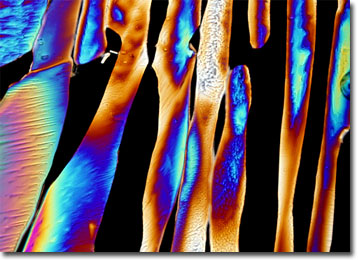Polarized Light Microscopy Digital Image Gallery
Malonic Acid
Sometimes alternatively referred to as propanedioic acid, malonic acid is a dicarboxylic acid of ethane with a methylene group separating the two carbonyl moieties. The substance occurs in small quantities naturally in urine and beetroot, but is typically prepared by hydrolyzing diethyl malonate.

Water-soluble, white, and crystalline, malonic acid, which is readily decomposed by heat and relatively unstable in its free form, has little practical use other than acting as a biochemical diagnostic probe for intermediary metabolism. The substance’s diethyl ester, however, is commonly utilized to synthesize barbiturates, vitamins B1 and B6, and various other compounds. The ester is created through a reaction of ethyl alcohol and cyanoacetic acid.
Unusually high levels of malonic acid in the urine is often an indication of a genetic disorder known as malonic aciduria. Though rare, the symptoms of the disorder, which may include vomiting, seizures, heart disease, low blood sugar, delayed development, and retardation, can be serious, especially in infants. Biochemically, those affected by malonic aciduria suffer from severe metabolic acidosis and a metabolic block in the vitamin B12 dependent conversion of propionyl CoA to succinyl CoA. The primary treatment for the condition is dietary, patients decreasing their intake of fat in order to increase their carbohydrate to fat ratio, as well as avoiding extended periods of time without eating so that they do not aggravate their tendency for hypoglycemia.
